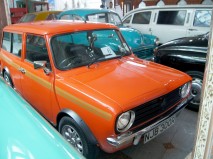1969 Mini Clubman
Production of the Clubman and 1275GT got off to a slow start because the cars incorporated "lots of production changes" including the relocation of tooling from the manufacturer's Cowley plant to the Longbridge plant: very few cars were handed over to customers before the early months of 1970.
Early domestic market Clubmans were still delivered on cross-ply tyres despite the fact that by 1970 radials had become the norm for the car's mainstream competitors.[54] By 1973 new Minis were, by default, being shipped with radial tyres, though cross-plies could be specified by special order, giving British buyers a price saving of £8.
The 1275GT is often incorrectly described as the "Mini Clubman 1275GT". The official name was always just the "Mini 1275GT", and it was a separate, distinct model from the Clubman (although it shared the same frontal treatment as the Mini Clubman, and was launched at the same time).
In 1971, the 1,275 cc Mini Cooper S was discontinued in the UK, leaving the Mini 1275GT as the only sporting Mini on sale for the rest of the decade. Innocenti in Italy, however, continued making their own version of the Mini Cooper for some time. While the UK built 1275GT was not nearly as quick as a 1275 Mini Cooper S, it was cheaper to buy, run, and insure. It was the first Mini to be equipped with a tachometer. It also featured a standard-fit close-ratio gearbox. Performance of the 1275GT was lively for the time, achieving 0–60 mph (97 km/h) in 12.9 seconds, and the excellent midrange torque offered a 30–50 mph (48–80 km/h) time in top gear of only nine seconds. The bluff front, however, meant that the model struggled to reach 90 mph (140 km/h).
Throughout the 1970s, British Leyland continued to produce the classic 1959 "round-front" design, alongside the newer Clubman and 1275GT models. The long-nose Clubman and 1275GT offered better crash safety, were better equipped, and had better under-bonnet access, but they were more expensive and aerodynamically inferior to the original 1959 design. The Mini Clubman and 1275GT were replaced in 1980 by the new hatchback Austin Metro, while production of the original "round-front" Mini design continued for another 20 years. At the end of Clubman and 1275GT production, 275,583 Clubman saloons, 197,606 Clubman Estates and 110,673 1275GTs had been made.




